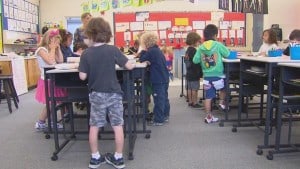Here’s an innovative idea. Ditching tables and chairs for standing desks at schools. That is just what this elementary school has done in San Rafael, California.
We are seeing more workplaces using standing desks and replacing chairs with yoga balls, so why not schools? Sitting for too long can have a negative impact on your health. In adults, sitting for long periods has been associated with organ damage, muscle degeneration, poor circulation and slowed brain function. Studies on the effects of prolonged sitting for children are limited, but our findings so far suggest similar results.
Sitting still and actively listening for an entire school day is a lot to ask of young children. Studies have shown a significant positive relationship between physical activity and cognitive function in children. While students may get some activity in physical education classes a few times a week (if they’re lucky), there is growing support for movement to be incorporated into regular instruction. Additionally, with a growing childhood obesity epidemic that begs for innovative interventions, standing desks just might be one piece of the puzzle.
Of course there are some drawbacks. Some worry standing all day can also be harmful. Form is important, which will likely be an issue for small children. To help, some doctors suggest alternating between standing and sitting throughout the day. Also, the cost of purchasing standing desks poses a problem for schools already lacking in funding. At Vallecito Elementary School, parents supportive of the idea paid for the desks through fundraising efforts and a non-profit was born to get every public school child a standing desk.
So far at Vallecito, it seems their efforts are paying off. The principal reports children are more focused, confident and productive after a few months of using the standing desks. At another school in Minnesota, a teacher incorporated standing desks into her classroom and similarly reported that standing up helped students focus on the lesson instead of trying to sit still at a traditional desk.
While standing up at a desk cannot replace physical activity, as these most recent findings suggest, it does allow for smaller movements, which is a good thing. A study that looked at why some people are prone to gain weight while others are not found that the thinner people “moved throughout the day, fidgeting, pacing, standing, bouncing on the balls of their feet, and jiggling their legs. That activity, which had mostly gone unnoticed, ended up accounting for a slow burn of as much as eight hundred extra calories.”
Imagine if kids could burn off their extra energy to help them focus and burn additional calories, all while learning in the classroom. That sounds like a win-win.

